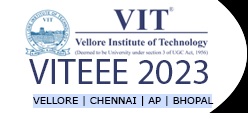VITEEE Physics Syllabus 2023 : VIT Engineering Entrance Exam
Organisation : Vellore Institute of Technology
Exam Name : VIT Engineering Entrance Examination VITEEE
Service Name : VITEEE 2023 Syllabus
Website : https://viteee.vit.ac.in/
VIT VITEEE Exam
Vellore Institute of Technology Engineering Entrance Examination (VITEEE) is conducted for admission to undergraduate engineering programmes in VIT group of Institutions. VITEEE will be conducted between 15 and 21 April 2023 (Tentative) at designated centres across India and abroad. VITEEE is a common entrance exam for VIT Vellore, VIT Chennai, VIT-AP and VIT- Bhopal.
Related / Similar Syllabus : GATE Geology And Geophysics (GG) Syllabus 2023

VITEEE Physics Syllabus
1. Mechanics and Properties of Matter
** Law of conservation of linear momentum and its applications. Static and kinetic friction laws of friction – rolling friction
** Work done by a constant force and a variable force; kinetic energy – work-energy theorem power.
** Conservative forces: conservation of mechanical energy (kinetic and potential energies) non-conservative forces: motion in a vertical circle – elastic and inelastic collisions.
** Elastic behaviour – Stress-strain relationship – Hooke’s law – Young’s modulus – bulk modulus shear modulus of rigidity – Poisson’s ratio – elastic energy. Viscosity – Stokes’ law – terminal velocity – streamline and turbulent flow – critical velocity. Bernoulli’s theorem and its applications.
** Heat – temperature – thermal expansion: thermal expansion of solids – specific heat capacity: Cp, Cv – latent heat capacity. Qualitative ideas of Blackbody radiation: Wein’s displacement Law – Stefan’s law.
2. Electrostatics
** Charges and their conservation; Coulomb’s law – superposition principle. Electric field – electric field due to a point charge, electric field lines; electric dipole, electric field intensity due to a dipole – behaviour of a dipole in a uniform electric field.
** Electric potential – potential difference- electric potential due to a point charge and dipole – equipotential surfaces – electrical potential energy of a system of two point charges.
** Electric flux-Gauss’s law and its applications. Electrostatic induction-capacitor and capacitance – dielectrics- electric polarisation – parallel plate capacitor with and without dielectric – applications of capacitor – energy stored in a capacitor – Capacitors in series and in parallel – Van de Graaff generator.
3. Current Electricity & Magnetic Effects of Electric Current
** Electric Current – drift velocity and mobility and their relation with electric current. Ohm’s law, electrical resistance – V-I characteristics – electrical resistivity and conductivity-classification of materials in terms of conductivity – Carbon resistors – colour code for carbon resistors – combination of resistors – series and parallel – temperature dependence of resistance – internal resistance of a cell – potential difference and emf of a cell – combinations of cells in series and in parallel.
** Kirchoff’s law – Wheatstone’s Bridge and its application – Metrebridge – special case of Wheatstone bridge – Potentiometer principle – comparing the emf of two cells.
** Magnetic effect of electric current – Concept of magnetic field – Oersted’s experiment – Biot
** Savart law- Magnetic field due to a current carrying straight wire and circular coil – Tangent galvanometer – Bar magnet as an equivalent solenoid – magnetic field lines.
** Ampere’s circuital law and its application. Force on a moving charge in uniform magnetic field and electric field – cyclotron – Force on current carrying conductor in a uniform magnetic field –
** Forces between two parallel current carrying conductors – definition of ampere.
** Torque experienced by a current loop in a uniform magnetic field – moving coil galvanometer conversion to ammeter and voltmeter – current loop as a magnetic dipole – Magnetic dipole moment of a revolving electron.
4. Electromagnetic Induction and Alternating Current
** Electromagnetic induction – Faraday’s law – induced emf and current – Lenz’s law. Self induction – Mutual induction – self inductance of a long solenoid – mutual inductance of two long solenoids. Methods of inducing emf –
(i) by changing magnetic induction
(ii) by changing area enclosed by the coil and
(iii) by changing the orientation of the coil. AC generator – (Single phase, three phase).
** Eddy current – applications – transformer -Alternating current – AC circuit with resistance – AC circuit with inductor – AC circuit with capacitor – LCR series circuit – Resonance and Q – factor – power in AC circuits.

Download VITEEE Physics Syllabus
Download Full VITEEE Physics Syllabus Here :
http://www.syllabus.gen.in/uploads/pdf2022/3067.pdf